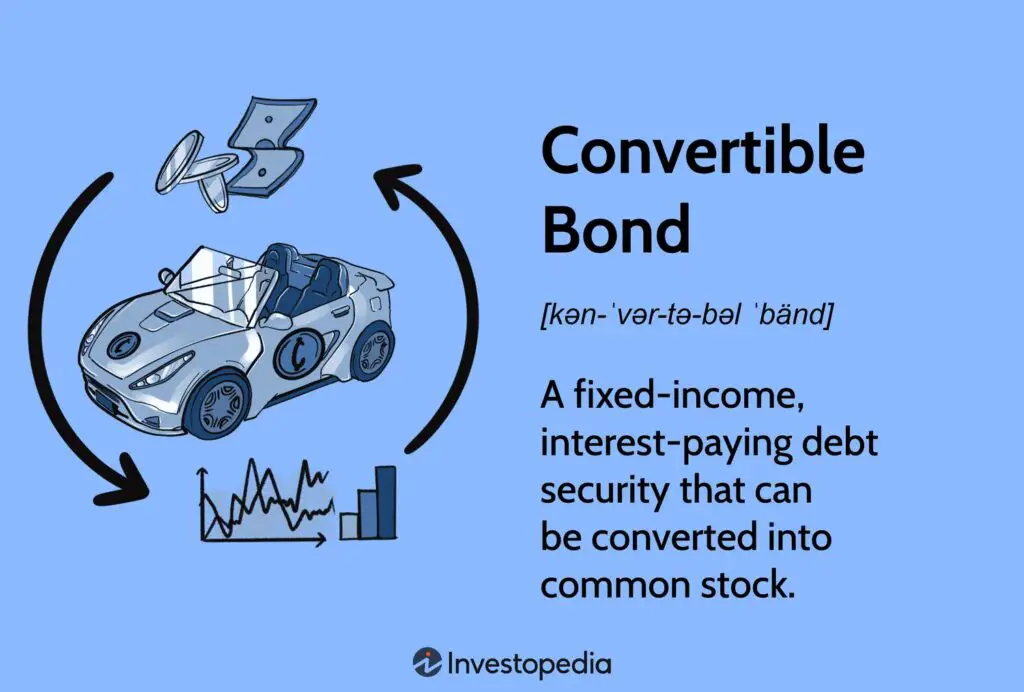Looking to diversify your investment portfolio? Consider a convertible bond! Wondering what is a convertible bond and its benefits? A convertible bond is a hybrid financial instrument that combines the features of a bond and a stock. It allows bondholders the option to convert their bonds into a predetermined number of common shares at a specified conversion price. This unique characteristic offers investors the potential for both fixed income from the bond and capital appreciation from the equity. In this article, we will delve deeper into what is a convertible bond and its benefits, providing you with valuable insights to make informed investment decisions. Let’s jump right in!
Understanding Convertible Bonds and Their Benefits
A convertible bond is a financial instrument that combines the features of a bond and a stock. It provides the bondholder with the option to convert the bond into a predetermined number of shares of the issuing company’s common stock.
Convertible bonds have gained popularity among investors in recent years due to their unique characteristics and potential benefits. In this article, we will explore what a convertible bond is and delve into its various advantages.
What is a Convertible Bond?
A convertible bond is a type of bond issued by a company that grants the bondholder the right to convert the bond into a specific number of common shares. These bonds have a fixed interest rate and term like traditional bonds, but they offer the added benefit of potential equity participation through conversion.
The conversion price, which specifies the predetermined number of shares the bondholder will receive upon conversion, is set at the time of issuance. This price is usually higher than the current market price of the company’s stock to provide an incentive for bondholders to hold onto the bond until conversion becomes economically favorable.
Key Features of Convertible Bonds
Convertible bonds possess several key features that differentiate them from traditional bonds and make them an attractive investment option for many individuals and institutions. These features include:
1. Conversion Option: The primary feature of a convertible bond is the embedded option to convert the bond into common shares of the issuing company. This conversion option provides potential upside if the company performs well and its stock price increases.
2. Fixed Interest Payments: Like traditional bonds, convertible bonds pay regular interest payments at a predetermined fixed rate throughout the bond’s term. These interest payments provide a steady income stream for bondholders.
3. Seniority: Convertible bonds are typically ranked senior to common stockholders but junior to traditional bonds in the event of the issuing company’s bankruptcy or liquidation. This seniority provides a higher level of security compared to common stock.
4. Call Provisions: Similar to traditional bonds, convertible bonds may have call provisions that allow the issuer to redeem the bonds before their maturity date. This feature provides the issuer with flexibility but can limit potential gains for bondholders.
Benefits of Investing in Convertible Bonds
Investing in convertible bonds offers several benefits that make them an appealing option for both individual and institutional investors. Let’s explore some of these advantages:
1. Equity Participation
The primary benefit of investing in convertible bonds is the potential for equity participation. By converting a bond into common stock, bondholders can benefit from any future increase in the stock price. This allows investors to capture potential gains in both the bond and equity markets, providing a unique combination of income and growth potential.
2. Diversification
Convertible bonds can serve as a valuable diversification tool within an investment portfolio. Due to their hybrid nature, they exhibit characteristics of both bonds and stocks. This diversification can help reduce overall portfolio risk and enhance returns by providing exposure to different asset classes.
3. Income Generation
Convertible bonds provide a fixed income stream through regular interest payments. This steady income can be particularly attractive to income-oriented investors seeking stable cash flows. The fixed interest payments offer a potential advantage over common stock dividends, which can fluctuate or be suspended during periods of financial stress.
4. Downside Protection
Due to their bond-like characteristics, convertible bonds offer a level of downside protection compared to holding common stock alone. If the stock price declines, the bond component of the convertible bond helps mitigate losses and preserves the bond’s value. This downside protection can be particularly appealing during market downturns or periods of heightened volatility.
5. Potential for Capital Appreciation
In addition to the fixed income provided by convertible bonds, investors have the opportunity to benefit from capital appreciation if the issuing company’s stock price increases. This potential for capital gains makes convertible bonds an attractive investment option for those seeking both income and long-term growth potential.
Risks Associated with Convertible Bonds
While convertible bonds offer numerous benefits, it’s important to understand and evaluate the associated risks. Some of the key risks to consider include:
1. Interest Rate Risk
Like traditional bonds, convertible bonds are exposed to interest rate risk. If interest rates rise, the value of the bond may decrease, as investors may prefer higher-yielding alternatives. Conversely, falling interest rates can increase the value of the bond.
2. Credit Risk
Convertible bonds are subject to credit risk, which refers to the potential default or failure of the issuing company to fulfill its debt obligations. Investors should carefully assess the creditworthiness of the issuer before investing in convertible bonds.
3. Volatility Risk
The price of convertible bonds can be influenced by stock market volatility. If the underlying stock experiences significant price swings, the value of the convertible bond may fluctuate accordingly. Investors with a low tolerance for volatility should consider this risk before investing in convertible bonds.
4. Liquidity Risk
Convertible bonds may have lower liquidity compared to traditional bonds or common stocks. This reduced liquidity can make it more challenging to buy or sell bonds, potentially leading to wider bid-ask spreads and increased trading costs.
5. Conversion Premium Risk
The conversion premium, which represents the premium paid over the current market price of the underlying stock, can affect the potential returns of convertible bonds. A higher conversion premium may result in a lower potential for capital appreciation if the stock price does not rise sufficiently.
Convertible bonds offer a unique investment opportunity, combining the income stability of bonds with the potential for equity participation. They provide investors with diversification benefits, steady income streams, and the potential for capital appreciation. However, it’s important to consider the associated risks, including interest rate risk, credit risk, volatility risk, liquidity risk, and conversion premium risk. By carefully evaluating these risks and understanding the benefits, investors can determine if convertible bonds align with their investment objectives and risk tolerance.
What is convertible bonds? Why would a company issue a convertible bond ?
Frequently Asked Questions
Frequently Asked Questions (FAQs)
What is a convertible bond?
A convertible bond is a type of bond that can be converted into a predetermined number of shares of the issuer’s common stock. It combines characteristics of both debt and equity instruments, giving the bondholder the option to convert the bond into equity.
What are the benefits of investing in convertible bonds?
Investing in convertible bonds offers several benefits, including:
How does a convertible bond work?
A convertible bond works by providing the bondholder with the option to convert the bond into a predetermined number of shares of the issuer’s common stock. This conversion can occur at any time during the bond’s life or at a specified conversion date.
What factors should be considered when evaluating a convertible bond?
When evaluating a convertible bond, it is important to consider factors such as the conversion price, conversion ratio, coupon rate, credit quality of the issuer, and the potential for capital appreciation of the underlying stock.
Are convertible bonds riskier than traditional bonds?
Convertible bonds can carry higher risks compared to traditional bonds. The value of convertible bonds is influenced by the price movements of the underlying stock, making them more volatile. However, they also offer potential for capital appreciation and downside protection through their bond component.
Are there any tax advantages to investing in convertible bonds?
Depending on the jurisdiction, there may be certain tax advantages associated with investing in convertible bonds. For example, in some cases, the interest income received from convertible bonds may be taxed at a lower rate than the dividends received from stocks.
Can convertible bonds provide income in addition to potential equity growth?
Yes, convertible bonds typically provide regular interest payments to bondholders until the bond is either converted into equity or reaches maturity. This income component makes them attractive to investors seeking both income and potential equity growth.
What are the risks associated with investing in convertible bonds?
Some of the risks associated with investing in convertible bonds include the risk of default by the issuer, interest rate risk, credit risk, liquidity risk, and the risk of changes in the price of the underlying stock. It is important for investors to carefully evaluate these risks before investing.
Final Thoughts
A convertible bond is a unique financial instrument that combines the features of a bond and a stock. It allows bondholders to convert their bonds into a predetermined number of shares of the issuing company’s common stock. This flexibility provides investors with the potential for capital appreciation while still offering the security of fixed income.
One of the key benefits of convertible bonds is the opportunity for investors to participate in the company’s growth potential. If the stock price rises, bondholders can convert their bonds and benefit from the increase in value. This potential upside makes convertible bonds an attractive investment option.
Moreover, convertible bonds offer downside protection due to their bond component. If the stock price declines, investors still have the assurance of receiving interest payments and the bond’s principal upon maturity. This added stability can mitigate potential losses compared to investing solely in the stock.
In summary, a convertible bond combines the advantages of both bonds and stocks, offering investors the potential for capital appreciation and downside protection. This unique feature makes it an appealing choice for those seeking to diversify their investment portfolio and balance risk and reward. So, if you are looking to explore investment opportunities, consider the benefits of a convertible bond.

